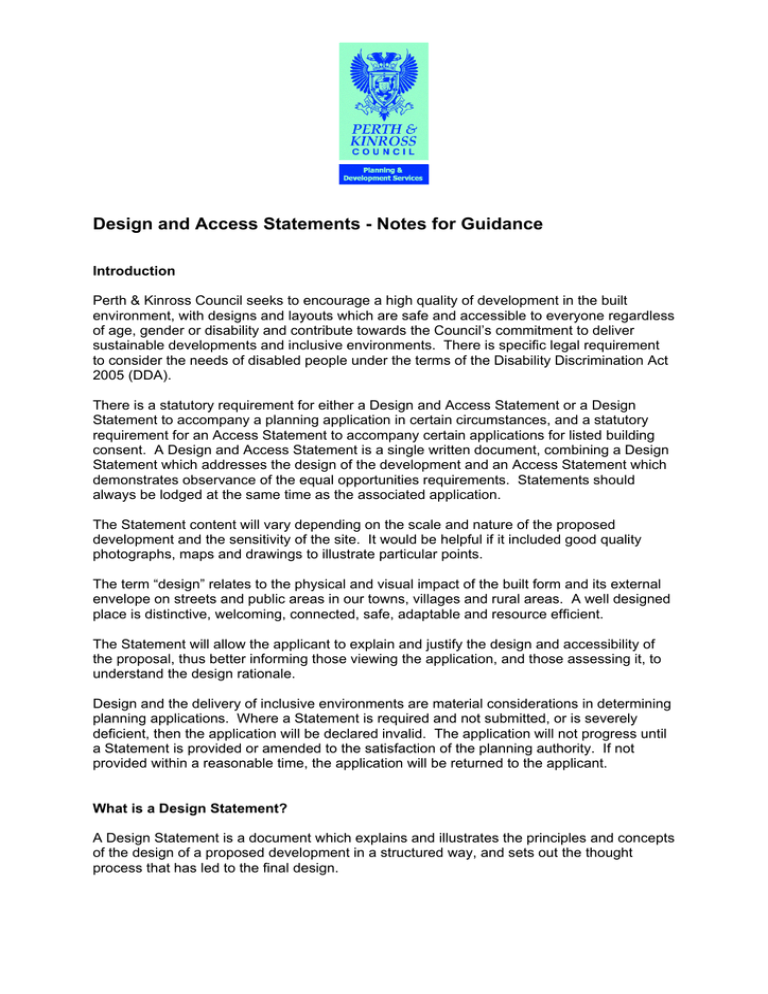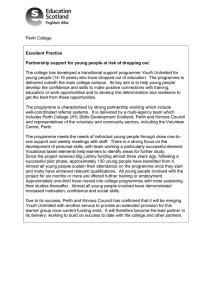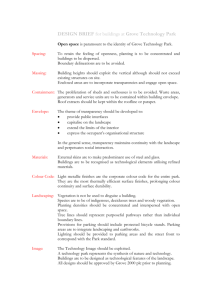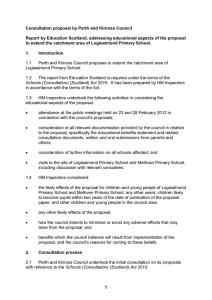Design and Access Statements
advertisement

Design and Access Statements - Notes for Guidance Introduction Perth & Kinross Council seeks to encourage a high quality of development in the built environment, with designs and layouts which are safe and accessible to everyone regardless of age, gender or disability and contribute towards the Council’s commitment to deliver sustainable developments and inclusive environments. There is specific legal requirement to consider the needs of disabled people under the terms of the Disability Discrimination Act 2005 (DDA). There is a statutory requirement for either a Design and Access Statement or a Design Statement to accompany a planning application in certain circumstances, and a statutory requirement for an Access Statement to accompany certain applications for listed building consent. A Design and Access Statement is a single written document, combining a Design Statement which addresses the design of the development and an Access Statement which demonstrates observance of the equal opportunities requirements. Statements should always be lodged at the same time as the associated application. The Statement content will vary depending on the scale and nature of the proposed development and the sensitivity of the site. It would be helpful if it included good quality photographs, maps and drawings to illustrate particular points. The term “design” relates to the physical and visual impact of the built form and its external envelope on streets and public areas in our towns, villages and rural areas. A well designed place is distinctive, welcoming, connected, safe, adaptable and resource efficient. The Statement will allow the applicant to explain and justify the design and accessibility of the proposal, thus better informing those viewing the application, and those assessing it, to understand the design rationale. Design and the delivery of inclusive environments are material considerations in determining planning applications. Where a Statement is required and not submitted, or is severely deficient, then the application will be declared invalid. The application will not progress until a Statement is provided or amended to the satisfaction of the planning authority. If not provided within a reasonable time, the application will be returned to the applicant. What is a Design Statement? A Design Statement is a document which explains and illustrates the principles and concepts of the design of a proposed development in a structured way, and sets out the thought process that has led to the final design. The Statement should demonstrate that the site and its surroundings have been fully appraised and that the final design solution promoted takes that context into account. The Statement should explain how the proposal takes into account national guidance, design policies within the development plan and any supplementary planning guidance, urban design strategy or Masterplan applicable to the site. It should state what, if any, consultation has been undertaken on issues relating to the design principles and concepts that have been applied to the development, and what account has been taken of the outcome of any such consultation. What is an Access Statement? An Access Statement explains how issues relating to access both to and through the site for those with disabilities have been addressed. The statement will need to show the proposed approach for balancing access needs with the protection of the building's special character. Where appropriate levels of accessibility cannot be achieved, the Statement will need to show solutions to minimise the impact on people with disabilities and provide services in other ways. When is a Design and Access Statement, a Design Statement or an Access Statement required? A Design and Access Statement must accompany all “national” and “major” category applications unless the proposed development is of a type listed within the prescribed exceptions. In terms of scale, sites of 2 hectares or more, residential developments of 50 units or more or agricultural buildings of 5,000 square metres or more all require a Design and Access Statement. A Design Statement is required for an application for a “local” development (unless the proposal is for the alteration or extension of an existing building) within the following sensitive areas: • Conservation Area • National Scenic Area • Site of a Scheduled Ancient Monument • Curtilage of a Category A Listed Building • Historic Garden or Designed Landscape • World Heritage Site (not applicable within Perth & Kinross) A Design Statement will be required for a marine fish farm development in limited circumstances. An Access Statement is required for each application for listed building consent where the access to the Listed Building is to be altered. A Design and Access Statement, a Design Statement or an Access Statement is not required for: • Development of an existing dwellinghouse or any development within the curtilage of such a dwellinghouse for any purpose incidental to the enjoyment of the dwellinghouse • Applications for planning permission in principle • A material change of use of land or buildings • Engineering or mining operations • Applications to vary or set aside conditions subject to which a previous planning permission was granted. The planning authority has the power to ask for a Design and Access Statement, even if not statutorily required, if it considers one is required to enable full and proper evaluation of the application concerned. We will normally require a Design Statement to accompany a planning application for five or more dwellings, or for a non-residential use of more than 0.5ha in site area, or where it affects the character and/or appearance of a Conservation Area, Historic Garden/Designed Landscape or the setting of a Listed Building or Scheduled Monument. We may also require a Design Statement where design sensitivity is considered a critical issue. What must a Design Statement include? The Statement must detail the design concept, including the context of the proposal, and how the proposal meets design policies. It should ideally include all the following information: 1. Background information – purpose of document, applicant and agent details, site location, description of proposal, ownership and development history, how the design will deliver an appropriate solution in terms of the site; 2. Site and context appraisal – examination of the site and surroundings. Depending on the site and proposed development, this is likely to refer to a number of the following factors: site description - e.g. adjacent land uses, boundary treatment, heritage conservation, focal points, landmarks, vistas, views (to/from/over site), topography, microclimate (wind, sun orientation, exposure, shelter); services – e.g. public utilities (underground services, drainage, overhead power lines), public services available locally (schools, public transport); surrounding buildings – e.g. existing settlement pattern, building lines, fenestration sizes and styles, active frontages, scale (height and massing), appearance (details and materials); use of space – between buildings (public, private), day, night, seasonal variation, prohibited activities, crime prevention measures (structure, surveillance, ownership, physical protection, activity); landscape – e.g. soft landscaping (landscape character, quality of landscaping, need for ground modelling, wildlife habitats, protected trees, play and recreational space), hard landscaping (street furniture, public art, condition and maintenance, public use); connections – e.g. vehicular movement (street layout, access, parking and circulation, public transport routes and stops, taxi stances, cycle ways, vehicular/pedestrian conflict, traffic calming measures, servicing arrangements), pedestrian access (movement to and from, desire lines, disabled access, current access restrictions). 3. Identification of the design principles - design principles are the general rules and guidance that inform and support the overall design of the proposal. The policy approach adopted should summarise the key policy drivers with reference to national guidance, development plan policies and planning guidance applicable. 4. Analysis and the development of the design concept - once the information has been gathered it can be analysed e.g. important views and landmarks, any features, habitats, trees or buildings to be retained, streets and spaces, accessibility, safety and security, sustainability and energy efficiency. From this information the design solution can be developed and an outline provided on how this is to be delivered. 5. The design solution - this section should justify the quality of the design adopted in the context of the site appraisal and design principles and should refer to the following: layout – the way in which buildings, roads and open spaces (both private and public) are placed and orientated in relation to each other and to surrounding buildings and spaces; landscape/landscaping – the way in which the buildings and landscape interact and the treatment of spaces to enhance or protect the site and its surroundings through hard and soft landscaping measures; scale and mix – the height, massing and type of building(s) in relation to the surroundings; appearance – the aspect of a place or building that determines a proposal’s visual impression, such as its built form, architectural detail, materials, fenestration, roof pitch, ornamentation, lighting, colour and texture. What must an Access Statement include? The Statement must explain the policy or approach adopted; outline how any policies relating to such access in the development plan have been taken into account; explain how any specific issues which might affect access to the development for disabled people have been addressed; describe how features which ensure access to the development for disabled people will be maintained; and state what, if any, consultation has been undertaken on issues relating to access to the development for disabled people and what account has been taken of the outcome of any such consultation. An Access Statement should also explain how access arrangements make provision both to and through the site to ensure disabled people have convenient access. It should consider accessible main entrances, desire lines, width and gradient, permeability, movement within public spaces where there may be level changes, use of contrasting surfaces to assist people with impaired vision, signage, lighting, public transport routes and the extent and location of dedicated accessible parking spaces which are designed so that drivers and passengers, either of whom may be disabled, can get in and out of their car easily. Internal aspects of individual buildings do not need to be included. This is a matter better considered under building standards legislation. However, the location and design of doors and windows, etc. will depend on an understanding of the internal layout of a building and may therefore be reflected in the Statement. Access panels are a useful source to consult on design as they are able to give advice based on personal experience and knowledge. A list of access panels is available from the Scottish Disability Equality Forum www.sdef.org.uk. Public Involvement A Design and Access Statement is a communication tool, which will help local communities, access groups and others to understand the design rationale and make useful comments and thereby inform the decision making process. This is the opportunity for information to be collected, access and design issues to be discussed, options evaluated and final proposals confirmed by the time the application is made. A draft statement should form part of any pre-application public consultation. Details of any design or access issues raised during the consultation process and how these have informed the final proposal need to be included in any Pre-application Consultation Report submitted with the planning application. If this approach is undertaken there is a greater chance that local communities will accept and support the proposals. Legislation • Town and Country Planning (Scotland) Act 1997, as amended by the Planning etc. (Scotland) Act 2006 • Town and Country Planning (Development Management Procedure) (Scotland) Regulations 2013 Scottish Planning Policy The Scottish Government is intent on raising the quality of urban design and the following publications may be useful: • Scottish Planning Policy (SPP) • Designing Places: A Policy Statement for Scotland • Designing Streets: A Policy Statement for Scotland • PAN 44 - Fitting New Housing into the Landscape • PAN 65 - Planning and Open Space • PAN 67 - Housing Quality • PAN 68 - Design Statements • PAN 71 - Conservation Area Management • PAN 75 - Planning for Transport • PAN 77 - Designing Safer Places • PAN 78 - Inclusive Design Also of relevance in terms of ‘Secured by Design’ is New Homes 2010 guide. This can be found at: http://www.securedbydesign.com/professionals/guides.aspx Local Planning Policy Perth & Kinross Council’s planning policies aim to raise placemaking, and therefore also design standards. The following development plan policies are particularly relevant: • TAYplan 2012 Policy 2: Shaping better quality places • Perth & Kinross Local Development Plan Policy PM1: Placemaking • Perth & Kinross Local Development Plan Policy PM2: Design Statements Further advice If you require further guidance with your design or access statement, please contact Development Management by email at developmentmanagement@pkc.gov.uk , by telephone on 01738 475300 and asking to speak to the duty planning officer or by sending an enquiry to Development Management, Pullar House, 35 Kinnoull Street, Perth PH1 5GD. Additional information is available on our website: www.pkc.gov.uk/planning Perth and Kinross Council Development Management Planning & Development June 2016




